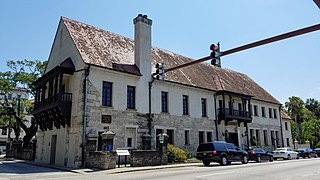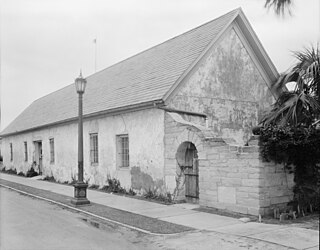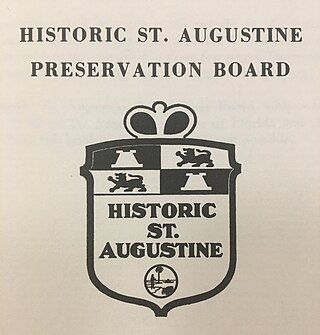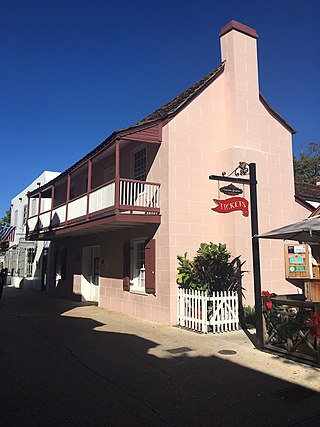
Fort Matanzas National Monument was designated a United States National Monument on October 15, 1924. The monument consists of a 1740 Spanish fort called Fort Matanzas, and about 100 acres (0.4 km2) of salt marsh and barrier islands along the Matanzas River on the northern Atlantic coast of Florida. It is operated by the National Park Service in conjunction with the Castillo de San Marcos National Monument in the city of St. Augustine.

The Castillo de San Marcos is the oldest masonry fort in the continental United States; it is located on the western shore of Matanzas Bay in the city of St. Augustine, Florida.
Anastasia Island is a barrier island located off the northeast Atlantic coast of Florida in the United States. It sits east of St. Augustine, running north–south in a slightly southeastern direction to Matanzas Inlet. The island is about 14 miles (23 km) long and an average of 1 mile in width. It is separated from the mainland by the Matanzas River, part of the Intracoastal waterway. Matanzas Bay, the body of water between the island and downtown St. Augustine, opens into St. Augustine Inlet.

St. Augustine National Cemetery is a United States National Cemetery located in the city of St. Augustine in St. Johns County, Florida. Located on the grounds of the active military installation known as St. Francis Barracks, the state headquarters of the Florida National Guard, it encompasses 1.4 acres (0.57 ha), and as of the end of 2005 had 2,788 interments. Administered by the United States Department of Veterans Affairs, it is currently closed to new interments. It was listed on the National Register of Historic Places in 2016.

The St Augustine Town Plan Historic District is a U.S. National Historic Landmark District encompassing the colonial heart of the city. It substantially encompasses the street plan of the city as contained within the bounds of walls built between the 16th and early 19th centuries. The district is bounded by Cordova, Orange, and St. Francis Streets, and Matanzas Bay. It was designated a National Historic Landmark in 1970, although its boundaries were not formally defined until 1986.

The González–Álvarez House, also known as The Oldest House, is a historic house museum at 14 St. Francis Street in St. Augustine, Florida. With a construction history dating to about 1723, it is believed to be the oldest surviving house in St. Augustine. It is also an important example of St. Augustine's Spanish colonial architectural style, with later modifications by English owners. It was designated a U.S. National Historic Landmark in 1970. The house is now owned by the St. Augustine Historical Society and is open for public tours as part of the Oldest House Museum Complex. Evidence can be seen of the Spanish, British, and American occupations of St. Augustine.

The Cathedral Basilica of St. Augustine is a historic cathedral in St. Augustine, Florida, and the seat of the Catholic Bishop of St. Augustine. It is located at 38 Cathedral Place between Charlotte and St. George Streets. Constructed over five years (1793–1797), it was designated a U.S. National Historic Landmark on April 15, 1970. Its congregation, established in 1565, is the oldest Christian congregation in the contiguous United States.

The Avero House is a historic house located at 41 St. George Street in St. Augustine, Florida, United States. The building is locally significant as one of 30 remaining houses within the historic district that pre-date 1821. It was once the site of a Minorcan Chapel. Today, the building is home to the St. Photios Greek Orthodox National Shrine.

Grace United Methodist Church is a historic church donated to the people of St. Augustine, Florida, by American industrialist Henry Morrison Flagler. It is located at 8 Carrera Street. Built within a one-year span, it was added to the U.S. National Register of Historic Places on November 29, 1979, for its architectural significance and as an example of community planning.

Ximenez-Fatio House Museum is one of the best-preserved and most authentic Second Spanish Period (1783-1821) residential buildings in St. Augustine, Florida. In 1973, it was added to the National Register of Historic Places. It was designated a Florida Heritage Landmark in 2012.

Government House, also known as Governor's House, is located at 48 King Street in St. Augustine, Florida, adjacent to the Plaza de la Constitución. The building, constructed of coquina, served as the governor's official residence from c. 1710 during the First Spanish Period (1565–1763), throughout the British Period (1763–1784), and until 1812 in the Second Spanish Period (1784–1821). Governor Gonzalo Méndez de Canzo was the first governor to build his residence on the present Government House site in 1598.

The King's Bakery is a coquina stone structure in St. Augustine, Florida, built during the British colonial period in the state (1763–1783). The building, located on Marine Street, with the rear facing Matanzas Bay, was constructed to supply bread to the British troops quartered across the street at the St. Francis Barracks, a building which formerly housed Franciscan friars, during the First Spanish Period (1565–1763). The monastery was used by the British as military barracks.

St. Francis Barracks is a historic structure constructed of coquina stone located on Marine Street in St. Augustine, Florida, named in honor of St. Francis of Assisi. The barracks were constructed between 1724 and 1755 by friars of the Order of St. Francis, to replace a series of wooden buildings which had been destroyed by the ravages of the tropical climate in La Florida and by fire, both accidental fires and occasional intentional ones, such as when the city was razed by the English in 1702.

Tolomato Cemetery is a Catholic cemetery located on Cordova Street in St. Augustine, Florida. The cemetery was the former site of "Tolomato", a village of Guale Indian converts to Christianity and the Franciscan friars who ministered to them. The site of the village and Franciscan mission is noted on a 1737 map of St. Augustine. A cemetery for the inhabitants of the village was also located on the grounds, with a portion of this cemetery set aside for former American black slaves, who had converted to Catholicism after escaping bondage in the Carolinas.

The González-Jones House is a historic home built during the First Spanish Period (1565–1763) in Saint Augustine, Florida. It is located at 56 Marine Street, one block north of the González–Alvarez House and the Saint Francis Barracks. This neighborhood includes nine colonial structures that survive in clusters along Marine and Saint Francis Streets. These buildings are all assumed to have been built after 1702, when the city was destroyed during a British siege.
The St. Augustine Historical Society (SAHS) is a membership organization committed to the preservation and interpretation of historically significant structures, artifacts, and documentary materials related to St. Augustine, Florida. Formally organized on New Years Day 1883, SAHS is the oldest continuously operating museum and historical society in Florida. In 1899, the society purchased the Vedder Museum on Bay Street where it exhibited historical and scientific curiosities until losing its holdings in the Saint Augustine Fire of 1914. In 1920, SAHS successfully lobbied for federal restoration of Fort Matanzas, and in 1965, it played a significant role in the restoration of numerous historic sites in preparation for the St. Augustine quadricentennial.

The Oliveros House is located at 59 St. George Street, St. Augustine, Florida. It was built of coquina during the Second Spanish Period in Florida (1565-1763). Today it is a reconstructed building, standing on original foundations which were unearthed during archaeological excavations.

The Historic St. Augustine Preservation Board (HSAPB) was a state agency in Florida that participated in the restoration and preservation of historic buildings in St. Augustine, Florida from 1959 to 1997. Created in 1959 by Governor LeRoy Collins, the agency acquired, restored, and preserved historic structures in St. Augustine until its abolishment by the State of Florida in June 1997.

The De Mesa-Sánchez House is located at 23 St. George Street in St. Augustine, Florida. It is a restoration of a home dating back to East Florida's First Spanish Period.

The Paredes-Dodge House is located at 54 St. George Street in St. Augustine, Florida. The one and a half story structure was built between 1803 and 1813, and is one of the only surviving colonial structures in St. Augustine.

























